The Buddy Club
Jessie Risen, PT, MPT, RetATC
Background
The school based physical therapist has the unique advantage of treating patients/students in their “working” and natural environment on a daily basis. This provides the opportunity to promote participation and physical activity in an environment for children both with and without disabilities in a familiar and easily accessible social and academic environment. According to the International Classification of Functioning, Disability and Health (ICF), participation is defined as an individual’s ability to interact with and complete a task while participating in a life situation.1 The school environment is the perfect example of a life situation where children with disabilities function and participate in academic, physical, and social interactions with their peers.
This project developed out of the need for more school sponsored leisure activities and clubs to promote physical and social integration and inclusion between children with disabilities and their non-disabled peers. The Buddy Club is an idea created to serve as a stepping stone to a similar program known as Unified Champion Schools (formerly known as Project Unify). However, Unified Champion Schools is not a required program that is adopted at all schools secondary to the time commitment of staff in both the Exceptional Children’s Program as well as the regular education department. Therefore, some school campuses have no structured physical and social opportunities to promote interaction between children with and without disabilities (aside from academics). I wanted children with disabilities and special needs in our county to have access to school sponsored clubs that could accommodate their specific needs. My goal for The Buddy Club was to create a smaller scale program presented as a club that would be manageable for teachers and staff to promote physical activities and socialization in the entire student body.
Product Development
In order to improve compliance and reduce barriers to participation, The Buddy Club was designed to meet on a monthly basis, during the school day, and on school campus in the gym. This reduced the need for additional staff and financial support from school administration. The targeted school for this project was a title I elementary school with two Multiple Disabilities (MU) classroom that served children kindergarten through 5th grade (K-5). First and foremost, I had to gain approval from school administration to move forward with this club on school campus. The school principal was immediately supportive of this project and gave me permission to organize this club and utilize the school campus and time during the school day as long as it did not take away from regularly scheduled academic activities. I decided to open the club to 5th graders (regular education) and K-5 students in the MU classrooms. I was able to communicate with teachers in both settings to coordinate a time that all students were available to participate in the activity that would not interfere with regularly scheduled academics during the school day on Mondays from 11:50-12:30pm. Then I had to secure a space for the even to take place. Our school’s physical education teacher was willing to offer his gym space for the club meeting since the proposed meeting time was an open and available space. Then I had to campaign for volunteers for the club. Several members of school staff were ready willing to participate and help in this project including MU classroom teachers and assistants, other school physical therapists/occupational therapist/speech therapists, and our adaptive physical education teacher.
Product
The Buddy Club has been meeting monthly on Mondays from 11:50-12:30pm on school campus since February. Meeting are still ongoing till the end of the school year. Each club meeting was developed to include a 15 minute physical activity session followed by an arts and crafts activity, team building activity, or academic related activity to promote socialization between both groups of children as well. During our first club meeting in February, students had to opportunity to play ball with each other as well create Valentine’s Day cards together.
February Buddy Club Valentines
Our March meeting included physical activities to meet the needs of all the individuals in the club. For example, students were paired up and asked to trace specific shapes with their extremities to promote movement within their capabilities. Some students were able to stand and demonstrate single leg balance and others were able to participate by tracing shapes with their arms with hand over hand assist from their peers as well as staff. This was followed by students helping each other create a “Buddy Bracelet” with inspirational words to promote leadership, citizenship, and friendship. The students were asked to share what words they found inspiring to represent the values of The Buddy Club and these words were transferred to their bracelets. To meet the communication needs of all of the students, the beaded letters were represented through the use of sign language to maximize independence and communication between all of the students.
March Buddy Club Bracelets
I am happy to say that our April event developed into a field trip. On April 21st, a small group of regular ed. 5th graders had the opportunity to join our MU classes in a field trip to the spring Special Olympics. They were “buddied” up and participated in a number of track and field events. Buddies were even able to run and compete with each other. Every participant was awarded with a Special Olympics medal when they placed in their events. With the assistance and coordination with our adaptive physical education teacher, each student who participated was able to receive an event t-shirt to represent their time and involvement with this Special Olympics event. This was a first time event for this particular school and all of the students and staff had a GREAT time!
The Buddy Club at Special Olympics
Assessments and Evaluations
Once the program was established I developed a parent child participation questionnaire to determine the baseline levels of physical activity and social interaction of both the exceptional children’s population as well as the 5th grade regular education students (I wanted to know the level of physical and social skill that my patient population was going to get to interact with and it serves as a constant measurement tool). Each family was contacted and asked to fill out and return the attached document (parent questionnaire) to assist with determining the needs of the students and planning the program activities around the needs of the parents and students. I loosely based my survey on some aspects of the Participation and Environment Measure for Children and Youth (PEM-CY) measurement. I added questions that I felt were more relevant to gaining the baseline information needed for this particular project. The PEM-CY itself is a tool that was developed to assess a child’s participation and environment in everyday activities located in the home, school, and community.2 The information gathered from the PEM-CY can provide assessors with information to guide policy, service design, and delivery decisions.2 In my case, I designed the survey to determine current level of participation in specific activities as well as the amount of time spent interacting with other peers. This information can then be carried over into determining initial level of interest in the participation in a group like the Buddy Club as well as providing information regarding club and activity design. For the purposes of the capstone project, I also included an updated release form for photo/video/student (though we already have generic ones signed by the participants). Family literacy was also taken into consideration secondary to the fact that several of the participants’ families speak Spanish only therefore all materials were translated into Spanish as well.
Additional evaluation was performed through both formal and informal communication with parents/caregivers and school staff through face to face communication, email, and telephone communication. I also developed a formal evaluation tool for school staff to fill out at the end of their experience and work with The Buddy Club. Since this is an ongoing project, the forms will be completed at the conclusion of The Buddy Club meetings.
Also, both the 5th grade students as well as the MU classroom students will be asked to write a short essay and reflection with ideas and suggestions for future meetings of The Buddy Club. Again, this will occur at the conclusion of The Buddy Club meetings in June.
Reflection
When I first presented the idea for The Buddy Club, I thought that support and volunteers would be difficult to find. But that was certainly the easiest part of the process. School staff and my peers were ready to assist me and this project which makes me extremely grateful to be part of such a great team. The most challenging part was scheduling. Finding a 40minute time slot during the academic school day to accommodate all of the students was difficult to organize. Most classes follow a specific schedule during the school day per grade level. However, the MU classes have multiple grade levels in each classroom (K-2, and 3-5). I felt fortunate that with the help of the classroom teachers, we were able to identify the Monday time slot. After the first meeting, scheduling continued to be a challenge because the school initiated their own weekly club meetings to occur during the identified “free” time slot on Mondays and the gym space was utilized for some of the new clubs. So we essentially lost our space and needed to relocate the club. I was able to reserve the OT/PT therapy room in the school to accommodate the students. The physical activities performed had to be adjusted to accommodate the smaller space but we made it work!
The most rewarding part of this project came from the students and their reactions to each other. At the end of our very first meeting during some down time, one of our EC students who is an avid dancer and cheerleader led a group of general education students in a cheer. She instructed them to follow along and these students exclaimed, “I had no idea she could do that.” A group of 5th grade students also gifted me at our most recent club meeting by stating, “Wait, can we do this every Monday?” Also, the students continue to wear their buddy bracelets to school which I am so proud of. Finally, Special Olympics today was extremely hot. Some of our 5th graders wore long sleeves and jeans and were so hot! I told him maybe next time we would try to advise the students to wear shorts because everyone was so hot. He stated “that’s okay, it wouldn’t matter what we wear! I had so much fun anyway!” Without student support and interest, this club could not have come to fruition.
Plan for the Future
My plan for the future would be that this club could serve as a model that could be carried over to and offered at other school campuses (elementary, middle, and high school). The Buddy Club could be offered to students just like any other school sponsored club like a running club, science club, or journaling club. Also, I hope that teachers could play a larger role in the organization and implementation of this program. This may reduce any barriers to participation especially in the area of scheduling. Based on informal student feedback, increasing the frequency of club meetings would be great. In order to make the program more manageable at an increased frequency, we could offer a fall and spring session of club meetings with a break during the winter months. I did develop a mock flyer that could promote more student members. This could be dispensed to students and families at the beginning of the school year at school open house events, posted on school campuses, or sent home in student book bags.
Acknowledgements
This project was absolutely a group effort that truly took the efforts of a “village” to be successful. First of all, I would like to thank my advisor, Karen McCulloch, PT, PhD, NCS, for keeping me focused (during this project and through my tDPT experience) and helping me narrow down my topic after a few failures.
Thank you to my committee members, Blythe Ardyson, MS, OTR/L, Amy DiTomasso, PT, DPT, and Stefanie Nance, MA/CCC/SLP for your expertise and feedback regarding this project. Blythe, I especially want to thank you for your passion and dedication to this project from the very beginning. Your commitment to our students inspires me to be a better practitioner every day.
Also, thank you to our awesome MU teachers, Ms. Cheryl Pitchford and Ms. Vanessa Richardson and their classroom assistants for your dedication to our students and your time and efforts in this project. Thank you to Ms. Tracy Siligmueller, school speech therapist, for your printing and laminating expertise.
Thank you to our 5th grade teachers, Mr. Rod Livingston, Ms. Maiya Howard, and Ms. Maggie Moore for showing interest and support for this program. Mr. Rod Livingston, I truly appreciate the lead role you took in the organization and communication for this project with staff in your grade level. Thank you principal Sabre Robinson, for supporting this club and giving us the green light to move forward with all of the activities on campus.
Thank you to our adaptive physical education teacher, Ms. Caroline Ebert for assisting in providing materials and instruction during club activities as well as including us in and coordinating our field trip to the spring Special Olympics event. It was awesome!
And last but not least, thank you to my husband Kenny and my two children Kaleb and Colton. I cannot express enough gratitude for your support, encouragement, and patience throughout this project and my tDPT experience. Thank you guys for not letting me give up!
References
1. Willis C, Girdler S, Thompson M, Rosenberg M, Reid S, Elliott C. Elements contributing to meaningful participation for children and youth with disabilities: A scoping review. Disabil Rehabil. 2016:1-14. doi: 10.1080/09638288.2016.1207716 [doi].
2. Coster W, Law M, Bedell G, Khetani M, Cousins M, Teplicky R. Development of the participation and environment measure for children and youth: Conceptual basis. Disabil Rehabil. 2012;34(3):238-246. doi: 10.3109/09638288.2011.603017 [doi].

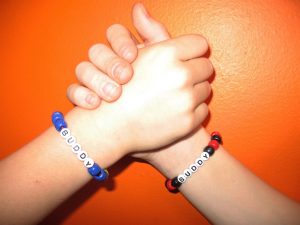


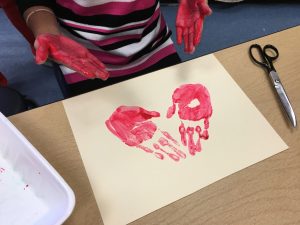
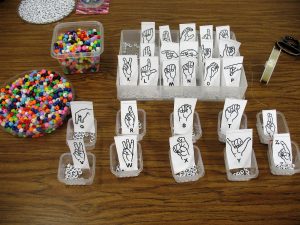


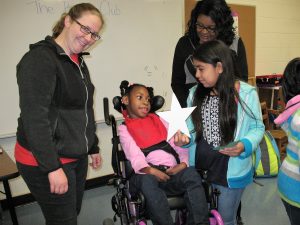
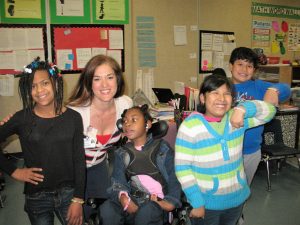
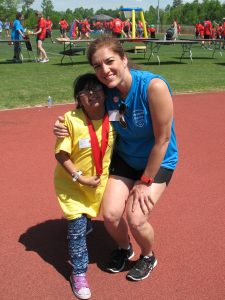
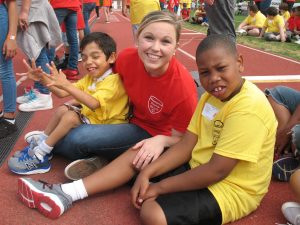


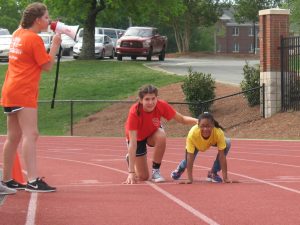
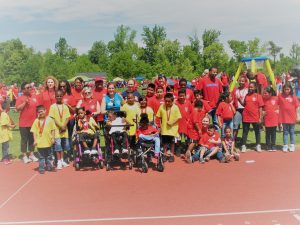
6 Responses to “The Buddy Club”
Jessie Risen
Kids chose some of the following words: partner, buddy, friend, trustworthy, leader, and lawnmower. I know lawnmower sounds different HOWEVER, I have a very good explanation for this. One of our MU students is obsessed with lawnmowers and has a deep love for them. And when asked about friendship and what he looks for as positive words to describe good qualities in a friend, his first response was lawnmower. He absolutely made a bracelet with the word lawnmower on it because it represents love and something positive for him!
Karen McCulloch
What words did kids choose for their buddy club bracelets? Just curious….
kmac
Jessie Risen
Yes! I did experience a major “detour” during my project proposals. My initial playground development proposal did not go over well at another location. Unfortunately the goals of the PTA and myself did not match as to what we felt the focus of the development of the project should be. That project’s timeline had a 5-10year development plan and needed a LOT of funding that was not necessarily going to be focused on adaptive playground equipment and access. Though this is going to be taken into consideration and would be addressed in the development, it was simply not a priority. So the lessons learned when attempting to propose an idea especially in the school system is to gain support from administration and the PTA if it calls for it. Clear communication is necessary to ensure that everyone is on board and has the same goals for the student population at the school. The support from a school’s PTA can be a great resource to help with any financial and volunteer needs.
Though my initial project fell through and didn’t gain a lot of support at my initial school location, I am extremely happy that I had the opportunity to develop a project at The Buddy Club’s school location. There was a need that was shared with administration, school staff, and students. This common need made the club successful. A project that has support and passion from those involved can overcome any financial and volunteer needs that may arise.
Thanks again for your encouragement and support!
-Jessie
KMac
It’s really great to see how this project evolved, Jessie – given there was a “detour” that was imposed by lack of PTA support for Plan A. The field trip to the SO event is genius, getting both buddies to compete together was awesome.
You’ve done a super job tracking through the program – congrats!!!
kmac
Jessie Risen
Hey Colleen!
Thank you so much for your comments! Yes, due to the fact that we only have 4 PT’s to cover our county, my hopes for the future would be to have it led by teachers. Since each school is specifically assigned to a PT, that PT for the school could serve as the initial contact and assist to set up the club but then allow for delegation of responsibilities to the teachers in the classrooms for these meetings. The other great benefit of being a school based physical therapist is that we have the flexibility of potentially using this time to work toward specific IEP goals during these club meetings. This may encourage the physical therapist to remain hands on with these club meetings as well (but with teachers taking the lead in scheduling and organizing) since we more than likely serve the children who are in the club anyway! i.e. we could “hit two birds with one stone” by promoting the club as well as working toward specific IEP goals. Thanks again for your comment and encouragement! I really appreciate it.
Colleen Johnson
Jessie,
Your project is AMAZING! I cannot imagine how much work you have put into its development but it seems as though the kids absolutely love it. I think the integration between the children with and without disabilities must be so rewarding for all involved. The bracelets are great! In regards to your “Plan for the Future” do you foresee it becoming a more teacher led club? I know there are only a few therapists to go around all of Alamance County! Again, you did and incredible job, you should be so proud!
Colleen